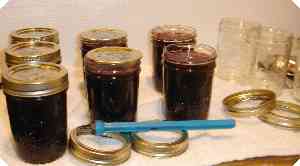Looking for How to Make and Can Elderberry Juice - Easily! With Step-by-step Directions, Photos, Ingredients, Recipe and Costs in 2025? Scroll down this page and follow the links. And if you bring home some fruit or vegetables and want to can, freeze, make jam, salsa or pickles, see this page for simple, reliable, illustrated canning, freezing or preserving directions. There are plenty of other related resources, click on the resources dropdown above. If you are having a hard time finding canning lids, I've used these, and they're a great price & ship in 2 days.
If you have questions or feedback, please let me know! There are affiliate links on this page. Read our disclosure policy to learn more.
How to Make and Can Elderberry Juice - Easily! With Step-by-step Directions, Photos, Ingredients, Recipe and Costs
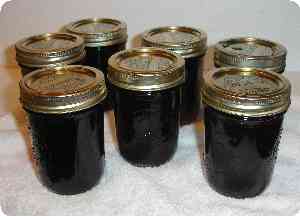 How to Make and Can Elderberry Juice
How to Make and Can Elderberry Juice
Also good for elderberry wine
Yield: 7 to 9 pint jars
Click here for a PDF print version
Canning your own elderberriy juice also quite easy. Here's how to make it, in 12 easy steps and completely illustrated. These directions work equally well for regular sugar, low sugar, no sugar, fruit juice-sweetened and Stevia (in a prepared form like Truvia, it measures same as sugar; if you use another form, you will need do your own conversion) - or Splenda, if you prefer, -sweetened jam.
For more information about elderberries, see Elderberries.
Ingredients
- Fruit - fresh elderberries - any quantity - the crunch
down some, so you will need about 1 and 1/4 pints raw per pint jar
finished.
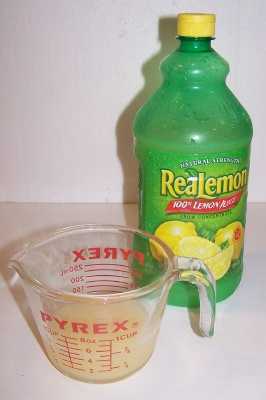
- Lemon juice - either fresh squeezed or bottled. Alternatively, Citric acid (brand name, fruit fresh).
- Sugar or sweetener - About 3 cups of dry, granulated (table) sugar. See step 6. It is possible to make low-sugar, fruit juice-sweetened, or Stevia (in a prepared form like Truvia, it measures same as sugar; if you use another form, you will need do your own conversion) - or Splenda, if you prefer, -sweetened fig jam; I'll point out the differences below.
Equipment
- Jar grabber (to pick up the hot jars)- Big box stores and grocery stores sometimes carry them; and it is available online - see this page. It's a tremendously useful to put jars in the canner and
take the hot jars out (without scalding yourself!). The kit sold
below has everything you need, and at a pretty good price:
- 1 large pot; I prefer 16 to 20 quart Nonstick ceramic coated pots for easy cleanup.
- Large spoons and ladles,
- 1 Water Bath Canner (a huge pot to sanitize the jars after filling (about $30 to $35 at mall kitchen stores, sometimes at big box stores and grocery stores.). Note: we sell canners and supplies here, too - at excellent prices - and it helps support this web site!
- Half pint canning jars (Grocery stores, like Publix, Kroger, Safeway carry them, as do some big box stores - about $7.50 per dozen pint ounce jars including the lids and rings)
- Jar funnel ($5 at Target, other big box stores, and often grocery stores; and available online - see this page) or order it as part of the kit with the Jar grabber .
- Lids - thin, flat, round metal lids with a gum binder that seals them against the top of the jar. They may only be used once.
- Rings - metal bands that secure the lids
to the jars. They may be reused many times.
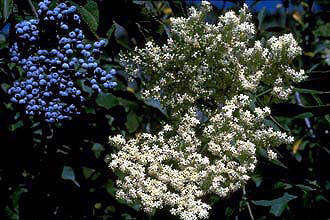
Optional stuff:
- Lid lifter (has a magnet to pick the lids out of the almost-boiling water where you sanitize them. ($4 at big box stores or it comes in the kit at left)
- Juicer
Directions - Step by Step
This example shows you how to make elderberry juice!
Step 1 - Pick the elderberries! (or buy them already picked)
It's fun to go pick your own and you can obviously get better quality ones!
I prefer to grow my own; which is really easy - but that does take some space and time.
If you want to pick your own, here is a list and links to the pick your own farms.
Step 2 - How much fruit?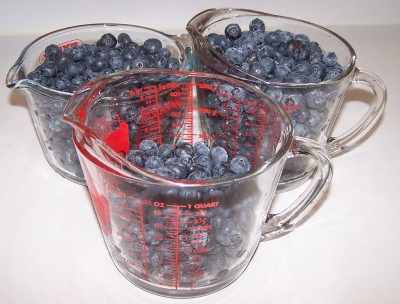
An average of 25 pounds of fruit is typically needed per canner load of 7 quarts of fruit juice. Of course, this varies! Or to make 9 pints of juice, you will need an average of 16 pounds of fruit. If you are buying in bulk, a "lug" weighs 26 pounds and yields 7 to 9 quarts of juice; which is an average of 3-1/2 pounds of fruit needed per quart of juice.
Step 3 - Wash the jars and lids
Now's a good time to get the jars ready, so you won't be rushed later. The dishwasher is fine for the jars; especially if it has a "sanitize" cycle, the water bath processing will sanitize them as well as the contents! If you don't have a dishwasher with a sanitize cycle, you can wash the containers in hot, soapy water and rinse, then sanitize the jars by boiling them 10 minutes, and keep the jars in hot water until they are used.
 NOTE: If a canning recipe calls for 10 minutes or more of process time in the canner, then the jars do not need to be "sanitized" before filling them.
But really, sanitizing them first is just good hygeine and common sense! See this page for more detail about cleaning and sanitizing jars and lids.
NOTE: If a canning recipe calls for 10 minutes or more of process time in the canner, then the jars do not need to be "sanitized" before filling them.
But really, sanitizing them first is just good hygeine and common sense! See this page for more detail about cleaning and sanitizing jars and lids.
Put the lids into a pan of hot, but not quite boiling water (that's what the manufacturer's recommend) for 10 minutes, and use the magnetic "lid lifter wand" to pull them out.
Leave the jars in the dishwasher on "heated dry" until you are ready to use them. Keeping them hot will prevent the jars from breaking when you fill them with the hot juice.
Step 3 -Wash the fruit!
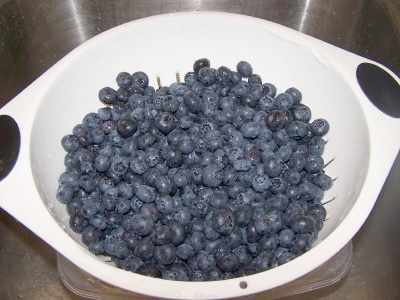 I'm sure you can figure out how to wash the
fruit in a
large bowl under running plain
cold water. The only tedious part is removing the berries from the stems!
I'm sure you can figure out how to wash the
fruit in a
large bowl under running plain
cold water. The only tedious part is removing the berries from the stems!
Remove the fruit from the stems and pick out any stems and leaves that became mixed in!
Step 4a - With a Steam or Mechanical Juicer or Press
If you are making large volumes, such as when making elderberry wine; you will want a juicer or press, like these:
See here for related tools, equipment, supplies on Amazon See here for related tools, equipment, supplies on Amazon See here for related tools, equipment, supplies on Amazon See here for related tools, equipment, supplies on Amazon See here for related tools, equipment, supplies on Amazon See here for related tools, equipment, supplies on Amazon See here for related tools, equipment, supplies on Amazon See here for related tools, equipment, supplies on Amazon
Step 4b - If you do not have a juicer; Heat the fruit on the stove
Put the berries in a pot and add enough water to just cover the fruit. Put the crushed fruit in a big pot on the stove over medium to high heat (stir often enough to prevent burning) for until it starts to boil, then reduce the heat and simmer for 10 minutes. We just want to soften the skins to help release the juice and break down some of the fruit to help it pass through our juice strainer.
Step 5 - Make and heat the syrup
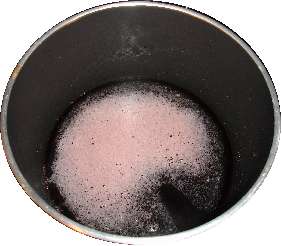 While
the berries are heating is a good time to make the syrup. Elderberries are
too sour for most people to drink the juice without a sweetener. Depending upon whi
While
the berries are heating is a good time to make the syrup. Elderberries are
too sour for most people to drink the juice without a sweetener. Depending upon whi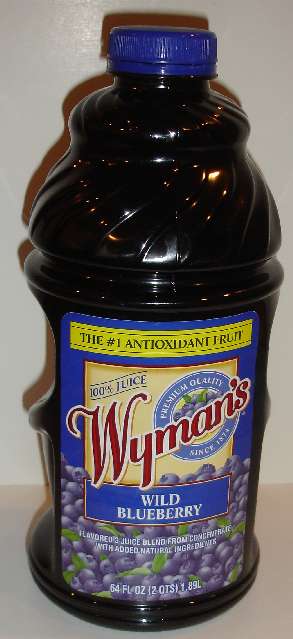 ch type of sweetener you want to use (sugar, no-sugar, Stevia (but you will have to experiment with amount, each brand of Stevia is a different concentration), or Splenda, or a mix of sugar and Stevia (or Splenda) or fruit juice) you will need to use a different
syrup from below. Adding syrup to canned fruit helps to retain its flavor,
color, and shape. It does not prevent spoilage of these foods. Heat the
syrup to near boiling in a pot.
ch type of sweetener you want to use (sugar, no-sugar, Stevia (but you will have to experiment with amount, each brand of Stevia is a different concentration), or Splenda, or a mix of sugar and Stevia (or Splenda) or fruit juice) you will need to use a different
syrup from below. Adding syrup to canned fruit helps to retain its flavor,
color, and shape. It does not prevent spoilage of these foods. Heat the
syrup to near boiling in a pot.
Most people prefer the medium syrup (highlighted) or elderberry juice with
added sugar!
|
Sugar syrup proportions for 7 to 9-pint jars of elderberries (double it for 9 quart jars) |
|||||
| Type of
syrup (Choose ONE) |
Water (cups) |
Fruit juice (cups) |
Sugar (cups) |
Powdered Stevia (in a prepared form like Truvia, it measures same as sugar; if you use another form, you will need do your own conversion) - or Splenda, if you prefer it | |
|---|---|---|---|---|---|
| 1 | Plain water | 7 | 0 | 0 | 0 |
| 2 | no calorie sweetener | 7 | 0 | 0 | 1/4 cup |
| 3 | Fruit juice (white grape or peach juice works well) | 0 | 7 | 0 | |
| 4 | Reduce calorie / fruit juice | 4 | 3 | 0 | |
| 5 | Fruit juice and Stevia (in a prepared form like Truvia, it measures same as sugar; if you use another form, you will need do your own conversion) - or Splenda, if you prefer, | 0 | 7 | 0 | 1/2 cup |
| 6 | very low calorie | 7 | 0 | 1/4 | 1/4 cup |
| 7 | very light (10% sugar) | 7 | 0 | 1 | 0 |
| 8 | light (20% sugar) | 6 | 0 | 2 | 0 |
| 9 | medium (30% sugar) | 6 | 0 | 3 | 0 |
- Nutrasweet (aspartame) will NOT work - it breaks down during heating).
- Honey can be used, substituting 1 for 1 with sugar, but may separate.
- Stevia (in a prepared form like Truvia, it measures same as sugar; if you use another form, you will need do your own conversion) - or Splenda, if you prefer, (sucralose) substitutes exactly with sugar BUT even the manufacturers of Splenda will tell you that you get best results if you just use a 50-50 mix; half regular sugar and half Stevia (in a prepared form like Truvia, it measures same as sugar; if you use another form, you will need do your own conversion) - or Splenda, if you prefer, . Same goes for Stevia.
- Sugar not only affects the sweetness, but also the color and flavor. It does not affect the preserving or spoilage properties - that has to do with acid and the processing method.
Step 6 - Sieve the cooked elderberries
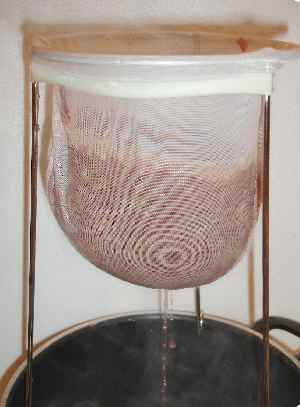 You can either put the soft cooked
fruit through a
juice strainer
(about $9.00, see ordering at right) which results in the most clear
juice and is easiest to use, or pour them through cheesecloth in
a colander. Or if you don't mind chunky juice, just let the juice stand
for 20 minutes, and decant (pour off) the clear liquid to use and leave
the seeds and solids behind.
You can either put the soft cooked
fruit through a
juice strainer
(about $9.00, see ordering at right) which results in the most clear
juice and is easiest to use, or pour them through cheesecloth in
a colander. Or if you don't mind chunky juice, just let the juice stand
for 20 minutes, and decant (pour off) the clear liquid to use and leave
the seeds and solids behind.
Discard the dry pulp. The yield of the juice should be about 41/2 to 5 cups.
You may also want to run the crushed cooked fruit through a Foley food mill (about $20 - see this page) BEFORE the juice strainer - unless you ran the fruit through a juicer, the food mill would help to extract more juice and separate the seeds, stems and skins that will clog the strainer. It's not necessary, but helps you get the most out of the fruit.
If you need a stopping point and want to finish up the next day, this is a good place. Sometimes, fruit juice gets crystals, called tartrate crystals, forming in the juice. They're not harmful and don't affect the taste, but some people don't like the appearance. I rarely even see them! But if you do, let juice stand in a in the fridge overnight, then strain through two thicknesses of damp cheesecloth to remove any crystals that have formed.
There is also a VERY nice, versatile strainer pictured at far right! Click on the links there or see the bottom of this page for more information and to order! The VillaWare model can handle higher volumes than a Foley food mill (without giving you cramps!)
To see a greater variety of strainers in other types, sizes, and prices, click here!
Step 7 - Polishing and further filtering
If you read the USDA's guide, they have additional steps to polish the juice so it is crystal clear. I don't bother with these as it adds a day or two to the process and most people like the natural look, anyway!
But if you do want the polished look, here what to do:
- Refrigerate juice from step 6 for 24 to 48 hours.
- Without mixing, shaking or disturbing it, carefully pour off clear liquid and save; discard the sediment.
- If desired, you may now strain through a paper coffee filter for a clearer juice.
- Continue to step 8.
Step 8 - Get the lids warming in hot (but not boiling) water
If you didn't do so already, put the lids into a pan of hot water for at least several minutes; to soften up the gummed surface and clean the lids.



Need lids, rings and replacement jars?
Get them all here, delivered direct to your home, at the best prices on the internet!
Step 9 - Sweeten (if desired) and bring to a boil
I
find that homemade elderberry juice, made using sweet fresh fruit, rarely nee ds
any additional sweetness. However if you have a sweet tooth or are
using very tart fruit, this is the time to add your sweetener (sugar,
Stevia (in a prepared form like Truvia, it measures same as sugar; if you use another form, you will need do your own conversion) - or Splenda, if you prefer, , honey, etc.).
ds
any additional sweetness. However if you have a sweet tooth or are
using very tart fruit, this is the time to add your sweetener (sugar,
Stevia (in a prepared form like Truvia, it measures same as sugar; if you use another form, you will need do your own conversion) - or Splenda, if you prefer, , honey, etc.).
Bring the juice to a boil.
Step 10 - Fill the jars and put the lid and
rings on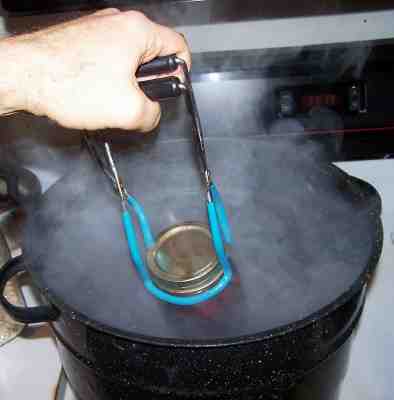
Fill them to within 1/4-inch of the top, wipe any spilled juice off the top, seat the lid and tighten the ring around them. Then put the filled jars into the canner!
This is where the jar tongs come in really handy!
Step 11 - Process the jars in the boiling water bath
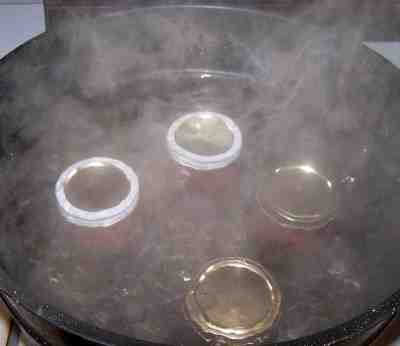 Keep
the jars covered with at least 2 inches of water. Keep the water boiling.
Keep
the jars covered with at least 2 inches of water. Keep the water boiling.
See the table below for the length of time to process the jars recommended for your altitude and size of jars used.
|
Recommended process time for Fruit Juice in a boiling-water canner. |
|||
| Process Time at Altitudes of | |||
| Jar Size | 0 - 1,000 ft | 1,001 - 6,000 ft | Above 6,000 ft |
| Pints or Quart jars |
5 min |
10 minutes | 15 minutes |
| Half-Gallon jars | 10min | 15 minutes | 20 minutes |
Step 12 - Remove and cool the jars - Done!
 Lift the jars out of the water with your jar lifter tongs and let them cool without touching or
bumping them in a draft-free place (usually takes overnight) You can then remove the rings if you like, but if you leave them on, at least loosen them quite a bit, so they don't rust in place due to trapped moisture. Once the jars are cool, you can check that they are sealed verifying that the lid has been sucked down. Just press in the center, gently, with your finger. If it pops up and down (often making a popping sound), it is not sealed. If you put the jar in the refrigerator right away, you can still use it. Some people replace the lid and reprocess the jar, then that's a bit iffy. If you heat the contents back up, re-jar them (with a new lid) and the full time in the canner, it's usually ok.
Lift the jars out of the water with your jar lifter tongs and let them cool without touching or
bumping them in a draft-free place (usually takes overnight) You can then remove the rings if you like, but if you leave them on, at least loosen them quite a bit, so they don't rust in place due to trapped moisture. Once the jars are cool, you can check that they are sealed verifying that the lid has been sucked down. Just press in the center, gently, with your finger. If it pops up and down (often making a popping sound), it is not sealed. If you put the jar in the refrigerator right away, you can still use it. Some people replace the lid and reprocess the jar, then that's a bit iffy. If you heat the contents back up, re-jar them (with a new lid) and the full time in the canner, it's usually ok.
Once cooled, they're ready to store. I find they last up to 12 months if kept in a cool dark place, like a basement..
Other Equipment:
|
From left to right:
|
Canning kit with Stainless Steel Steam Rack,Canning Funnel, Jar Lifter, Jar Wrench, Lid Lifter, Canning Tongs, Bubble Remover Tool |
 |
|
You can get all of the tools in a kit here: See here for related tools, equipment, supplies on Amazon |
|
 Granite Ware 21 QT, 9 Piece Enamelware Water bath Canning Pot with Canning kit, Colander and Rack VKP Brands Water Bath AND Steam Canner, 20 Quart Stainless Steel, flat-bottomed Induction range compatible and safe for smooth top ranges. 
|
Home Canning KitsSee the seller's website for more information, features, pricing and user reviews! This is the same type of standard canner that my grandmother used to make everything from applesauce to juices and jellies to tomato and spaghetti sauce. This complete kit includes everything you need and lasts for years: the canner, jar rack, Jar grabber tongs, lid lifting wand, a plastic funnel, labels, bubble freer, and the bible of canning, the Ball Blue Book. It's much cheaper than buying the items separately. You will never need anything else except jars and lids (and the jars are reusable). To see more canners, of different styles, makes and prices, click here!
|
Canning booksCanning & Preserving for Dummies
|
|||||||
The All New Ball Book Of Canning And Preserving: Over 350 of the Best Canned, Jammed, Pickled, and Preserved Recipes PaperbackThis is THE book on canning! My grandmother used this book when I was a child. It tells you in simple instructions how to can almost anything; complete with recipes for juice, jellies, pickles, sauces, canning vegetables, meats, etc. If it can be canned, this book likely tells you how! Click on the link below for more information and / or to buy (no obligation to buy)
Click here for more information about the Ball Blue Book of Preserving
|
Summary - Typical Cost of Making Homemade Elderberry Juice - makes 6 jars, 16 oz (pint) each** |
||||
| Item | Quantity | Cost in 2025 | Source | Subtotal |
| Fruit | 4 lbs | $2.00/lb | Pick your own | $8.00 |
| Canning jars (pint size), includes lids and rings | 12 jars | $8.50/dozen | Grocery stores, like Public, Kroger, Safeway and sometimes, Big Lots, local hardware stores and big box stores | $8.50 |
| Sugar | 4 cups | $3.00 | Grocery stores, like Public, Kroger, Safeway and sometimes, Big Lots, local hardware stores and big box stores | $3.00 |
| Total | $19.50 total or about $3.25 per jar |
|||
|
** - This assumes you already have the pots, pans, ladles,, and reusable equipment. Note that you can reuse the jars and reduce the cost further; just buy new lids (the rings are reusable, but the flat lids are not)! |
||||
Can't find the equipment? We ship to all 50 states!
Use our Feedback form!
Answers to Common Questions
- Why should cooked juice be made in small batches?
If a larger quantity of juice is used, it will be necessary to boil it longer thus causing loss of flavor, darkening of juice, and toughening of juice. It really doesn't work. Trust me; I've tried many times! - Can I use frozen or bottled juice instead of fresh?
Yep! Good flavored fruit can be hard to find fresh and are expensive! Juice works just fine, just start with step 7. Just be sure to get unsweetened juice. You can use frozen concentrate; just follow the directions on the package in terms of how much water to add. - What do I do if there's mold on my jellied fruit product?
Discard jams and jellies with mold on them. The mold could be producing a mycotoxin (poisonous substance that can make you sick). USDA and microbiologists recommend against scooping out the mold and using the remaining jam or juice. - Why did my jellied fruit product ferment, and what do I
do?
Jellied fruit products may ferment because of yeast growth. This can occur if the product is improperly processed and sealed, or if the sugar content is low. Fermented fruit products have a disagreeable taste. Discard them. - I just finished making my second batch of elderberry juice. The
first one came out perfect, the second one is not clear like the
first. I'm sure the taste is fine, it's just the appearance.
You can clarify the juice more next time. Try filtering it through several layers of cheesecloth or muslin - or even coffee filters. Also try avoiding any contact with metals - use plastic, glass and/or Teflon coated bowls and cookware - acids in the juice may react with the metals to become cloudy! - What happens if my jam or juice doesn't gel?
Remaking cooked runny jam or juice instructions can be found on this page
Illustrated Canning, Freezing, Jam Instructions and Recipes
[ Easy Home Canning Directions] [FAQs - Answers to common questions and problems] [Recommended books about home canning, jam making, drying and preserving!] [Free canning publications to download and print]
Looking for canning equipment and supplies?
Water bath canner with a jar rack
Pressure canners for gas, electric and induction stoves: Presto 23Qt or T-fal 22Qt
Canning scoop (this one is PERFECT)
Ball Blue book (most recent version)
Jars: 8oz canning jars for jams
Find Other types of farms:
Farm markets and roadside stands
Road trips and camping resources
Local Honey, apiaries, beekeepers
Consumer fraud and scams information
Home canning supplies at the best prices on the internet!
Maple Syrup Farms, sugarworks, maple syrup festivals
Environmental information and resources
Farms For Your Event for birthday parties, weddings, receptions, business meetings, retreats, etc.
Festivals - local fruit and vegetable festivals
Get the
most recent version of
the Ball Blue Book
With this Presto 23 quart pressure canner and pressure cooker, you can "can" everything, fruits, vegetables, jams, jellies, salsa, applesauce, pickles, even meats, soups, stews. Model 01781

You can make jams, jellies, can fruit, applesauce, salsa and pickles with water bath canners, like this Granite Ware 12-Piece Canner Kit, Jar Rack, Blancher, Colander and 5 piece Canning Tool Set


